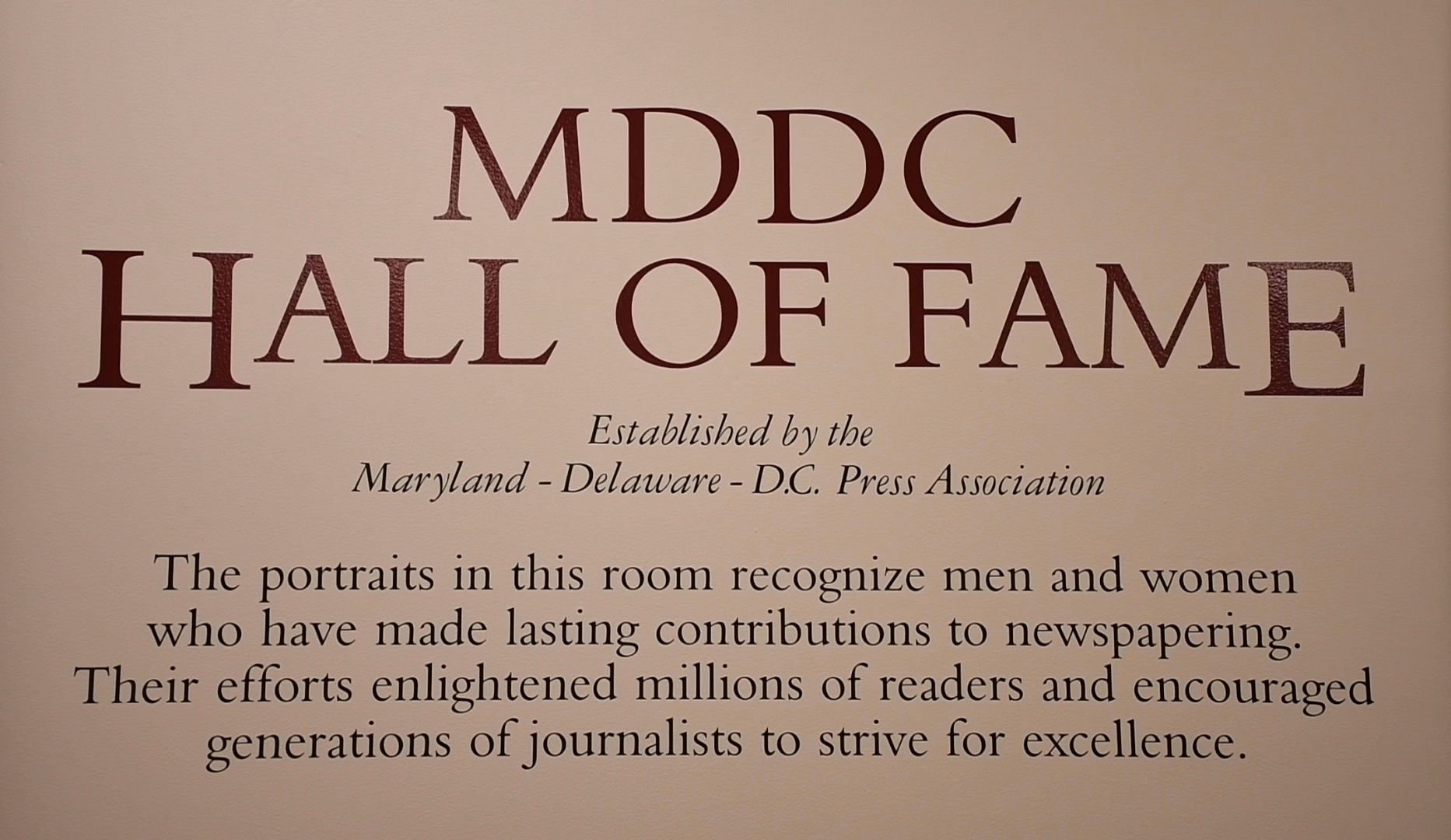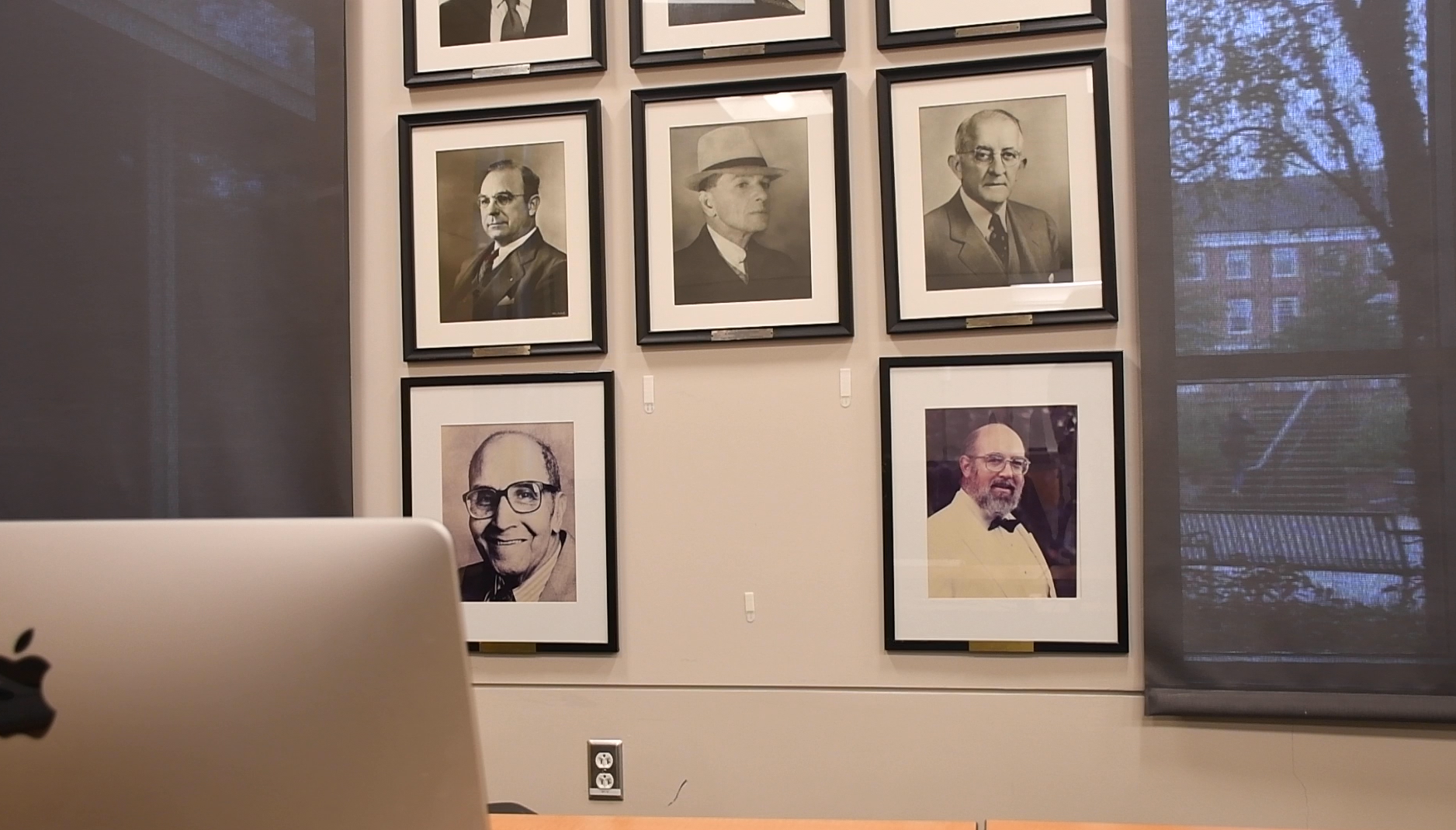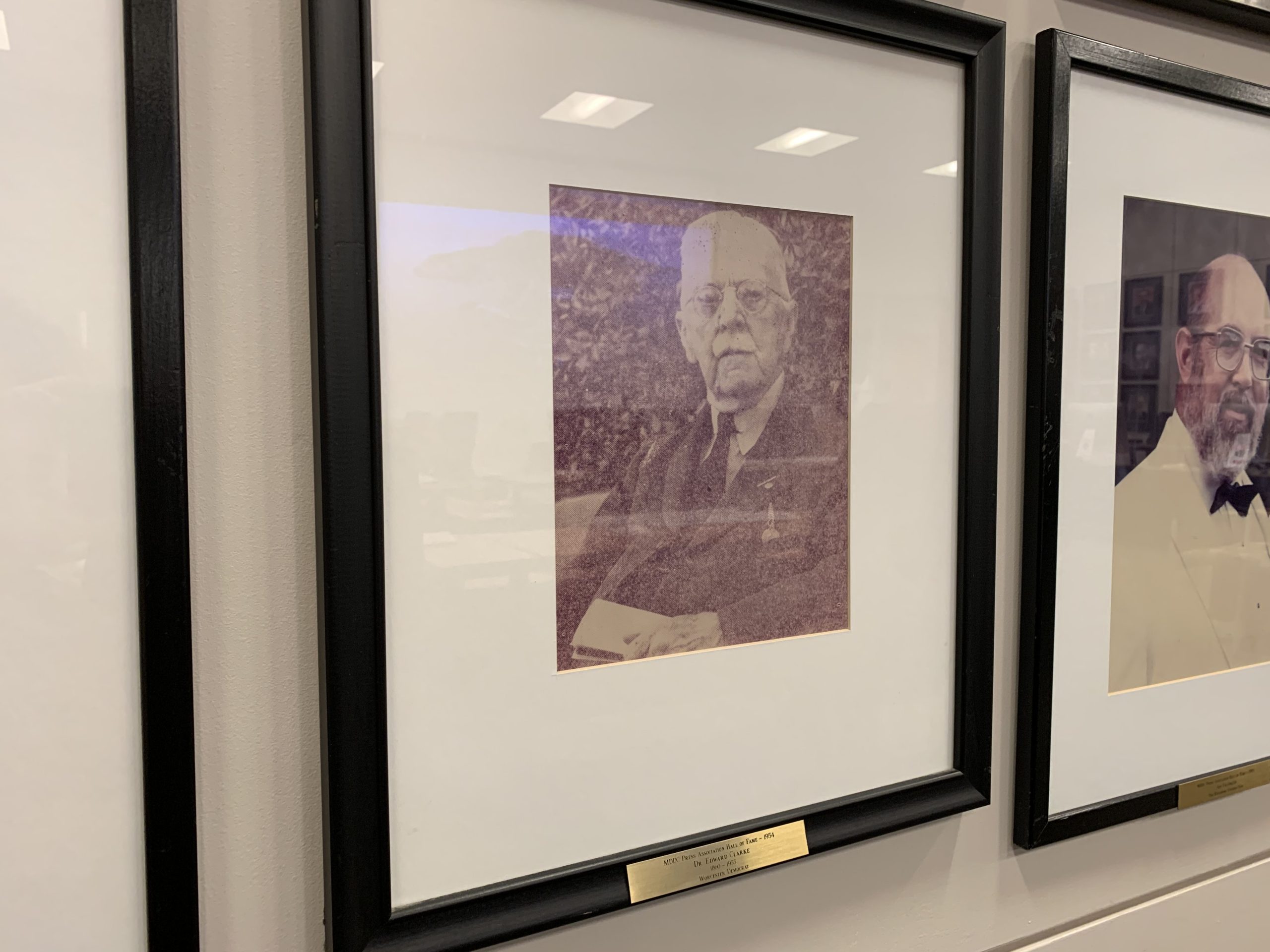By Gabriel Pietrorazio
COLLEGE PARK, Md. — It began with questions about why almost all the faces on the wall of honor in the journalism building at the University of Maryland’s flagship campus were of white men.
“We are grateful that MDDC was an early contributor to the capital drive that resulted in the construction of Knight Hall and creation of the Hall of Fame room,” read the May 5 letter from the Philip Merrill College of Journalism faculty and staff to the Maryland-Delaware-District of Columbia Press Association.
“While it has been an honor to exhibit these Hall of Famers in our college, students have noted that the vast majority of the photographs displayed are of White men.”
This work is a collaboration of the Howard Center for Investigative Journalism and Capital News Service at the University of Maryland, Morgan State University, Hampton University, Howard University, Morehouse College, North Carolina Agricultural & Technical State University and the University of Arkansas.
It escalated when the probe by the college’s Howard Center for Investigative Journalism into the role of white-owned newspapers in fomenting lynching following the Civil War turned to research of newspapers on Maryland’s Eastern Shore. The reporting disclosed that a member of the MDDC Hall of Fame may have done much of what the project sought to ferret out.
Edward J. Clarke, a 1954 inductee into the Hall, was owner, publisher and editor of the Worcester Democrat, a weekly on Maryland’s largely rural Eastern Shore. In 1940, an unsigned, front-page commentary called for the lynchings of five Black suspects in the murder of a white farmer and the robbery and assault of his wife. Clarke, as editor and publisher, bore responsibility for publishing the piece.
“What right to life have such brutes as are now at large, or said to be; no more than a rabid dog, a poisonous snake, or a disease-spreading germ. The quickest method of annihilation of such garbage is to get rid of it in the most efficacious way — when once the guilt is assured,” the column read.
PRINTING HATE
EXPLORE ALL STORIES
“Give them the same road into the vast unknown, by which they sent their innocent victims. For such, a citizens’ court is as just a tribunal as the most dignified Bench and a rope’s end is as suitable and fitting a passage into eternity for such tripe as is the best seat of an electric chair.”
In early November, the MDDC announced in a statement that Clarke had been removed from its Hall of Fame “after a review of his published work revealed vile commentary, extreme racism and the promotion of lynching.”
He “published racist viewpoints with pride and leveled sharp criticism at others who disagreed,” the statement said.
“Clarke and his repugnant views are banished from any place of stature or honor within our association,” said Rebecca Snyder, MDDC’s executive director.
Clarke was prominent in Pocomoke City, where he lived on Clarke Avenue, a street that had been named in his honor, The Salisbury Times reported in his obituary atop its front page on Feb. 19, 1953. The Times described the 92-year-old man as the “oldest weekly newspaper editor in the east.”

“He was fondly known to fellow Rotarians and other close friends as ‘Jukey,’” and was also “the oldest living graduate of St. John’s College, Annapolis,” the article said. For 31 years, Clarke taught at Washington College in Chestertown, Maryland, more than 100 miles up the road from where he published his newspaper.
“As evidence of his success,” the obituary read, “a bronze plaque was unveiled in 1941 in the administration building of Washington College commemorating his ‘long, faithful and valuable service as educator, executive, editor and publisher.’”
At the time he was inducted into the MDDC Hall of Fame, the press association’s president was Norman W. Harrington of The Star Democrat in Easton, another Eastern Shore newspaper.
Worcester County is on Maryland’s Atlantic coast, its Eastern Shore. During Clarke’s time at the Democrat, the county’s population was around 21,000.
Eastern Shore newspapers rarely covered Black life in their communities, with a notable exception. “When a black person was accused of a violent crime against a white person, local papers placed these stories prominently on the front page,” Sherrilyn A. Ifill, the NAACP Legal Defense and Educational Fund, Inc., president and director-counsel, wrote in a 2018 article for the Literary Hub website.
“Race was an explicit dimension of the local papers’ report on interracial crimes,” she wrote. “Black defendants were expressly identified by race, and their guilt in local papers seemed a certainty. The names of black defendants were optional. A black defendant could just as easily be referred to as a ‘confessed Negro slayer’ as by his name.
“The local papers were unabashedly partisan. Their interest in presenting Shore whites in the best possible light was openly admitted,” wrote Ifill, author of “On the Courthouse Lawn: Confronting the Legacy of Lynching in the Twenty-first Century,” which explores the lynchings on the Eastern Shore.
What is generally described as the last documented lynching in Maryland took place in October 1933 in Somerset County, next door to Worcester County. A white mob battered down the door to a jail in Princess Anne, Maryland, and abducted 22-year-old George Armwood, who had been accused of assaulting a 71-year-old white woman. He was beaten, stabbed and hanged twice; his body then burned and left in a lumberyard.
“Though state police officers identified nine men as leaders of the mob, a local grand jury declined to issue indictments, and local rioters later clashed with National Guardsmen seeking to arrest lynchers,” The Baltimore Sun reported in a chronicle of lynchings published in 2018. “Four men went to trial for the murder, but a jury dismissed all charges.”
In 1940, a white mob estimated to be as many as 1,000 gathered outside a Worcester County jailhouse where Lillian Blake and her 14-year-old daughter were being held as possible accomplices in a robbery in which a white farmer was killed and his wife shot in the back as she fled.
Blake’s husband, Arthur Collick, was the suspected shooter, but evaded the search party that captured the two Black women. The mob wanted assurances that he was not inside, and information from the women on where he might be.
The women were asleep at the time, but awakened as bottles and stones were being thrown into the cell through a window, Blake recounted later in an interview with The Afro-American, Baltimore’s Black weekly newspaper.
“Before they knew what was happening, the iron grating at the window had been yanked out and men were climbing through,” the newspaper reported. “Seeing the frightened couple the mobsters pulled them through the opening to the ground outside and prepared to take them to a large tree where the lynching was to take place.”
A short time later, however, Maryland state police officers wrested Blake and her daughter from danger. Collick was apprehended, tried, convicted and executed by hanging. Blake testified on behalf of the prosecution at the trial, even though, she said afterward, she had hoped he would not be sentenced to death.
The Worcester Democrat had begun regularly running a folksy column on its front page entitled “‘Chirps’ from the Democrat’s Pen.” It was unsigned and usually opined on talk about town and marriages. It carried no byline, but was published by Clarke.
The “Chirps” column immediately after the farmer’s death and before the shooter’s arrest argued for harsh punishment — legal or illegal — of those responsible for the killing and the assault on the farmer’s wife.
This particular column did not begin with its usual folksy salutation, “Well, sir,” and described the Black people allegedly involved as “fiends” and “savages.” It also noted that the crimes had taken place on Feb. 12, Abraham Lincoln’s birthday.
“A cold-blooded, premeditated savagely executed, dastardly attack,” the column branded the incident, “unprovoked, unwarrantable; an exhibition of murderous instincts, race hatred, and insatiable lust; an event which occurred on the birthday anniversary of a great American, who is cannonized almost by the Negro race as their deliverer from servile bondage — what a blasting argument against the possibility of good American citizenship ever evolving from the Fourteenth Amendment,” the Reconstruction amendment that granted citizenship rights and equal protection under the law to all those born in the United States.
“What about lynching!” the column read. “These fiends who violated the home of the Pilchard family are the vilest of lynchers. They were not content to live according to the law. They violate the strictest of mandates both from God and man; and yet they are to receive all the consideration of any other criminal, no matter what the sin. Lawless, they appeal to the law, and, in many cases, profit by the law’s delay and errors. Not willing to let others live, they seek by legal action to prolong their own lives; and regretfully, often succeeding by the law’s intracacies [sic].”
Across the top of the Democrat’s Feb. 16 front page, the main news article described as fact what unnamed and unmentioned sources said took place under a headline in all capital letters: “MURDER * ROBBERY * RAPE COMMITTED AT STOCKTON BY NEGROES SUN. NIGHT.”
“One of the worst crimes in the annals of Worcester County, was committed on Sunday evening, at the home of Mr. and Mrs. Harvey Pilchard; these very respectable people living near Stockton,” the first paragraph read.
“About 8 o’clock in the evening,” the article continued, “Mr. Pilchard answered a summons to his house door. When he opened it, he was shot down where he stood, killed by a charge from a shot gun in the hands of a burly negro.”
The news story reported in its third paragraph that a “fiend” then entered the house and demanded money from the woman, who complied. As she was escaping, however, the article said, “she was fired at and struck in the back by a bullet from a pistol in the hands of one of the brutes.”
The incident at the jail and its aftermath were barely mentioned in later “Chirps” columns. The Worcester Democrat did, however, publish news stories about the subsequent legal proceedings and sentencing of Collick and a juvenile accomplice, as well as Collick’s death, usually in the same tone and language of its initial report.
The week after the “Chirps” column on the averted lynching, the Democrat published two letters to the editor, one on the front page and another inside. The author of each one was identified only by a single initial.
The one on the front page “was duly signed and address given,” an introductory note read. “It was not intended for publication, therefore we refrain from revealing its author. We will say, however, it came from a resident of Wilmington, Delaware.”
The letter said the author had known the Pilchards and had visited the area near their home after the attack, talking to others who came by.
“I for one hope I can have a part in giving the prisoners ‘the same road into the vast unknown by which they sent their innocent victim,’” the letter read.
“I made a special effort to get the opinion of the masses on the case, and I know I can assure you your stand, as expressed in your editorial, is backed by a great majority of the citizens of that surrounding country.”
The second letter came from “A Worcester Countian, and seems to reflect the opinion of a large majority of citizens,” the introduction read.
“I have always tried to be a law abiding citizen and I am glad that we have one editor that has got nerve enough to print what he thinks right, without fear or favor. It really did me good to read your article. And it meets with my approval 100% and expresses my feelings in this matter better than I could have done myself.”
Dr. Frances “Toni” Draper, chief executive officer and publisher of the AFRO-American Newspapers, said reporters from Black-owned newspapers, unlike their competitors, were sometimes the only journalists who sat around the kitchen table with families and relatives to recount what Black people lived through on the Eastern Shore.
“It’s one thing to report the occurrence, and it’s another thing to put a human face to it,” Draper told the Howard Center. “I think that’s what the Black press does still well today.”
In the statement announcing Clarke’s removal from the Hall of Fame, MDDC said its executive committee “has called for further investigative reporting of Clarke and will make the results of that reporting public on completion.”
Snyder said the association would try to collect more information on Clarke “to provide more context’’ to his removal from the Hall. “I wouldn’t characterize it as like an investigation,’’ she said. “It’s a fact-finding mission.’’
Snyder seemed to be unaware of the front-page article in The Salisbury Times when Clarke died, the obituary in The Baltimore Sun, or of Clarke’s 25-year career at Washington College, and the plaque his students lobbied to have placed there in his honor.
Although obituaries exist for “most everybody else in the Hall,’’ she said “it was hard to find information about (Clarke). And I still have not, never located an obituary or anything really about him.’’
She said she doubted the association would reverse its decision. “I don’t think there’s any way that that would be invalidated,’’ she said.
She said the MDDC wants to “acknowledge and repair damages done’’ but has no plans for “analyzing every Hall of Fame inductee according to the standards of the 21st century.’’
“That’s a discussion, really, that I think we’re feeling our way through,” she said.
Lucy A. Dalglish, dean of Merrill College, said when the university was raising money to construct the new journalism building, Knight Hall, it offered naming rights and display opportunities to donors, a standard fundraising practice similar to naming rights sold or leased to corporate entities that pay to have their names on sports venues and concert halls.
Room 1011, which houses the MDDC Hall of Fame, was financed by $105,300 in donations to the college between 2008-2011. The five donors, all MDDC members, were John D. Worthington IV ($50,000); The Daily Record ($2,800); The Herald-Mail and Antietam Cable Television of Hagerstown, Maryand, an enterprise of Schurz Communications Inc. ($6,000); the Washington Examiner ($2,500); and Post-Newsweek Media and Gazette, plus several individual employees ($44,000.)
The MDDC Press Association and Foundation contributed no money for construction of the room, according to college records. However, the association and foundation have given the college $32,000 since 2000 for student scholarships and internship support.

Dalglish removed Clarke’s photo from Room 1101 in October when informed by a Howard Center reporter that an initial investigation had disclosed the racist writing in his newspaper. The dean said she acted unilaterally, then immediately informed the MDDC board she had taken down the photo.
“Board members concurred with removing the portrait,” she said.
Snyder said the MDDC did not object to the action of the dean, who serves as a trustee of the association’s nonprofit foundation.
“I think that for us,” Snyder said in the interview, “you know, you all had access to the primary information sooner than we did. … So once we had that access, we acted pretty quickly, but it also takes a minute. Like Lucy is a committee of one.”
Five African American journalists are in the Hall of Fame — including reporter Sam Lacy and editor and reporter Moses J. Newson of The Afro-American, and two members of the family that published those newspapers, Carl J. Murphy and John Henry Murphy Sr. The fifth is W. Curtis Riddle, who was an editor and reporter at The Baltimore Sun and later publisher of The News Journal in Wilmington, Delaware.
Dalglish said she is working with the MDDC to price out various options for redesigning the Hall of Fame room. The college of journalism has no role in selecting members for the Hall of Fame.
Snyder said MDDC and the college have a connection that is “really deep-seated and longstanding.”
Gannett Co., Inc., the nation’s largest newspaper group, bought the newspaper Clarke formerly owned in 2005. The Worcester County Times, as it is now known, is published weekly.
“The averted lynching that occurred during the 1940s is part of a dark period in our country’s history and is reprehensible,” Michael Feeley, the Gannett editor for Pennsylvania, Delaware and Maryland and secretary of the MDDC board of directors, said in an email on Oct. 27. “Gannett did not own the publication during that time, and the views expressed in the publication in the 1940s certainly do not reflect modern-day Gannett.”


